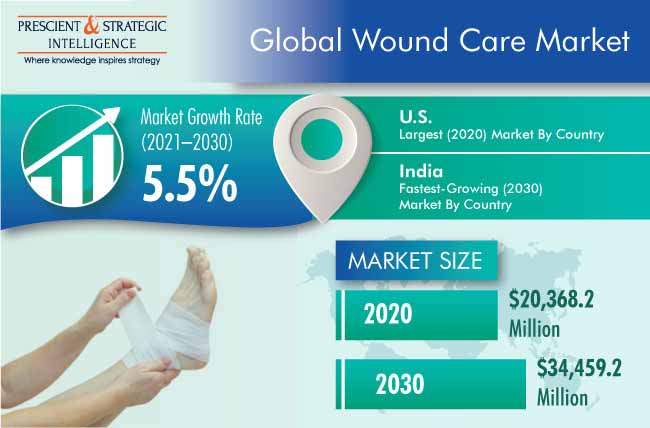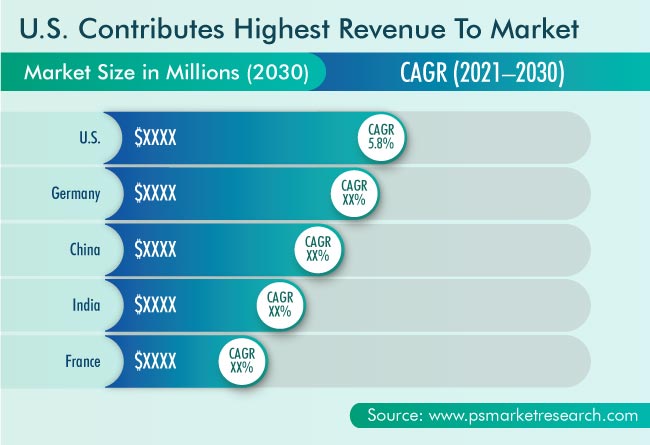Report Code: 10206 | Available Format: PDF | Pages: 325
Wound Care Market Research Report: By Product Type (Advanced, Traditional, Wound Closure), Wound Type (Diabetic Foot Ulcer, Pressure Ulcer, Surgical & Traumatic Wound, Burn, Venous Leg Ulcer), Age Group (Under 14, 14-49, 50-64, 65-74, 75-80, Above 80 ), End User (Hospital & Clinic, Homecare Setting, Long-Term Care Setting) - Global Industry Revenue Estimation and Demand Forecast to 2030
- Report Code: 10206
- Available Format: PDF
- Pages: 325
- Report Description
- Table of Contents
- Market Segmentation
- Request Free Sample
Market Overview
The global wound care market generated $20,368.2 million revenue in 2020, and it is expected to grow at a CAGR of 5.5% during the forecast period (2021–2030). The key factors responsible for the growth of the market include the growing geriatric population, increasing prevalence of diabetes, high rate of injuries and trauma cases, surging prevalence of chronic wounds, and rising cases of burns.
During the COVID-19 pandemic, the demand for wound care products have been reduced, due to the movement restrictions, which have forced people to stay home, and thus, there is a huge decline in incidence of injuries among school and college students. In addition, the number of road accidents have been decreased, due to the reduced usage of transport systems and vehicles. Moreover, companies faced disruption in the supply chain during the first wave in 2020, which is again being observed in 2021. Thus, there has been a negative impact of the pandemic on the sale of wound care products.

Demand for Advanced Wound Care Products Is Highest, Due to their Faster Wound Healing Property
The advanced category held the largest share in 2020 in the wound care market, based on product type. This is majorly attributed to the facts that the advanced wound care products accelerate healing of wounds, as they facilitate proper oxygen flow, maintain stable temperature surrounding the wound, provide protection from infection, remove dead tissues, allow new cells to emerge, and relieve pain during dressing change.
Diabetic Foot Ulcer (DFU) Category To Witness Fastest Growth, Due to Higher Prevalence of Diabetes
The DFU category is expected to witness the fastest growth in the wound care market during the forecast period, based on wound type. This can be majorly due to the high incidence of diabetes mellitus, which has a higher rate of occurrence in older population.
Due to Largest Patient Pool, Hospital & Clinic Category Accounts for Largest Revenue Share
Hospital & clinic has emerged as the largest revenue-generating category amongst all end users in the wound care industry, owing to the greater footfall of patients and increasing accessibility of hospitals to all income level population.
Age Group 14–49 Category To Witness Fastest Growth, Owing to Rise in Incidence of Diabetes
The age group 14–49 category is projected to represent the fastest growth during the forecast period. This can be primarily attributed to the highest exposure of individuals in this category toward factors causing wounds and injuries, and the rising incidence of diabetes.
North America Leads the Market, Due to High Healthcare Spending
Geographically, North America is expected to lead the wound care market throughout the analysis period. This can be attributed to the greater presence of industry players, high healthcare spending, and increase in research and development (R&D) activities in the region. On the other hand, the APAC market is expected to witness the fastest growth during the forecast period, mainly on account of growing geriatric population and surging number of cases of burns and traumatic wounds.

Shift in Preference Toward Advanced Wound Care Products
Globally, preference of patients is shifting toward advanced wound therapies from traditional therapies. The advanced wound products, such as hydrogel dressings and hydrocolloid dressings, provide optimal quick comfort and recovery to patients, along with adequate protection to accelerate the healing process. For example, Coloplast A/S’s Biatain Alginate is a highly absorbent alginate dressing for moderate-to-heavy exuding wounds. Similarly, ConvaTec Group PLC’s AQUACEL Ag Foam is a silver foam dressing that offers rapid and effective antimicrobial action.
Rising Geriatric Population Is Driving the Market Growth
Increasing aging population is playing a pivotal role in the growth of the wound care market. According to the World Population Ageing 2019 report, published by the United Nations (UN), there were 703 million people aged 65 years or above in 2019, and this number is set to rise up to 1.5 billion by 2050. Aging leads to the increasing risks of skin damages and wound problems. Common age-related changes, like reduced skin elasticity, and slower collagen replacement, and weakened body functions, leading to a longer recovery period for a wound to heal, in comparison to adults.
Increasing Incidence of Diabetes Is Propelling the Market Growth
The number of diabetic patients is increasing at a significant rate, worldwide. According to the International Diabetes Federation (IDF), in 2019, approximately 463 million adults between 20 and 79 years of age were living with diabetes, which is predicted to reach to 700 million by 2045. Moreover, according to the statistics published by the Centers for Disease Control and Prevention (CDC), in 2020, more than 34.2 million people had diabetes in the U.S. Furthermore, with the rising number of the elderly and obese people, it is expected that the prevalence of diabetes will continue to increase rapidly. During the management of diabetes, frequent dressing is required. Also, in diabetic patients, wounds tend to heal more slowly and develop quickly. So, with the growing diabetic population, coupled with the aging issues, the demand for wound care products is increasing swiftly, across the world.
| Report Attribute | Details |
Historical Years |
2014-2020 |
Forecast Years |
2021-2030 |
Base Year (2020) Market Size |
$20,368.2 Million |
Market Size Forecast in 2030 |
$34,459.2 Million |
Forecast Period CAGR |
5.5% |
Report Coverage |
Market Trends, Drivers, and Restraints; Revenue Estimation and Forecast; Segmentation Analysis; Country Breakdown; Impact of COVID-19; Companies’ Strategic Developments; Company Profiling |
Market Size by Segments |
By Product Type; By Wound Type; By Age Group; By End User; By Region |
Market Size of Geographies |
U.S; Canada; Germany; France; U.K.; Italy; Spain; Russia; Belgium; Netherlands; Switzerland; Japan; China; India; Australia; South Korea; Brazil; Mexico; Saudi Arabia; South Africa |
Secondary Sources and References (Partial List) |
Centers for Disease Control and Prevention; Centers for Medicare & Medicaid Services; International Agency for Research on Cancer; International Diabetes Federation; Ministry of Health, Labor and Welfare; National Center for Biotechnology Information; Organisation for Economic Co-operation and Development; United Nations Conference on Trade and Development; United States Food and Drug Administration; U.S. National Library of Medicine; World Health Organization |
Explore more about this report - Request free sample
Market Players Involved in Mergers and Acquisitions to Gain Significant Position
The global wound care market is fragmented in nature with the presence of several key players. Some of the major players in the industry include Hollister Incorporated, DeRoyal Industries Inc., ConvaTec Group plc, Smith & Nephew PLC, Mölnlycke Health Care AB, 3M Company, Essity AB, Paul Hartmann AG, B. Braun Melsungen AG, Coloplast A/S, Beiersdorf AG, Integra LifeSciences Holdings Corporation, Wright Medical Group N.V., and Johnson & Johnson .
In recent years, the players in the wound care industry have been involved in mergers and acquisitions, in order to attain significant position. For instance:
- In January 2021, Integra LifeSciences Holdings Corporation announced that it completed the previously-disclosed acquisition of ACell Inc. The acquisition of ACell Inc. and its proprietary MatriStem UBM technologies would enable Integra to provide more comprehensive complex wound management solutions to address its customers’ most pressing clinical challenges.
- In October 2019, 3M Company completed the acquisition of Acelity Inc. and its KCI subsidiaries for a total enterprise value of approximately $6.7 billion, including assumption of debt and other adjustments. The acquisition would help the company expand its medical solutions business and support its strategy to offer comprehensive advanced and surgical wound care solutions.
Key Players in Wound Care Market Include:
-
Hollister Incorporated
-
DeRoyal Industries Inc.
-
ConvaTec Group plc
-
Smith & Nephew PLC
-
Mölnlycke Health Care AB
-
3M Company
-
Essity AB
-
Paul Hartmann AG
-
B. Braun Melsungen AG
-
Coloplast A/S
-
Beiersdorf AG
-
Integra LifeSciences Holdings Corporation
-
Wright Medical Group N.V.
-
Johnson & Johnson
-
Tecoquimicas S.A.
Market Size Breakdown by Segment
The global wound care market report offers comprehensive market segmentation analysis along with market estimation for the period 2014–2030.
Based on Product Type
- Advanced
- Dressing
- Foam
- Hydrocolloid
- Film
- Alginate
- Antimicrobial
- Hydrogel
- Collagen
- Hydrofiber
- Wound contact layer
- Superabsorbent
- Therapy device
- Negative pressure wound therapy (NPWT) device
- Pressure relief device
- Biologic
- Skin substitute
- Growth factor
- Collagen-based
- Dressing
- Traditional
- Bandage
- Fixation tape
- Gauze
- Sponge
- Abdominal pad
- Wound Closure
- Suture
- Hemostat
- Surgical staple
- Adhesive & tissue sealant
- Wound closure strip
Based on Wound Type
- Diabetic Foot Ulcer (DFU)
- Pressure Ulcer
- Surgical & Traumatic Wound
- Burn
- Venous Leg Ulcer (VLU)
Based on Age Group
- Under 14
- 14–49
- 50–64
- 65–74
- 75–80
- Above 80
Based on End User
- Hospital & Clinic
- Homecare Setting
- Long-Term Care Setting
Geographical Analysis
- North America
- U.S.
- Canada
- Europe
- Germany
- France
- U.K.
- Italy
- Spain
- Russia
- Netherlands
- Belgium
- Switzerland
- Asia-Pacific (APAC)
- Japan
- China
- India
- South Korea
- Australia
- Latin America (LATAM)
- Brazil
- Mexico
- Middle East and Africa (MEA)
- Saudi Arabia
- South Africa
In 2030, the value of the wound care market will be $34,459.2 million.
Advanced is the largest category under the product type segment of the wound care industry.
The major wound care market drivers are growing geriatric population, increasing prevalence of diabetes, high rate of injuries and trauma cases, surging prevalence of chronic wounds, and rising cases of burns.
North America is the largest and APAC is the fastest-growing wound care market.
Most wound care market players are adopting mergers and acquisitions strategy to sustain their business growth.
Want a report tailored exactly to your business strategy?
Request CustomizationWant an insight-rich discussion with the report author?
Speak to AnalystOur dedication to providing the most-accurate market information has earned us verification by Dun & Bradstreet (D&B). We strive for quality checking of the highest level to enable data-driven decision making for you
Our insights into the minutest levels of the markets, including the latest trends and competitive landscape, give you all the answers you need to take your business to new heights
With 24/7 research support, we ensure that the wheels of your business never stop turning. Don’t let time stand in your way. Get all your queries answered with a simple phone call or email, as and when required
We take a cautious approach to protecting your personal and confidential information. Trust is the strongest bond that connects us and our clients, and trust we build by complying with all international and domestic data protection and privacy laws